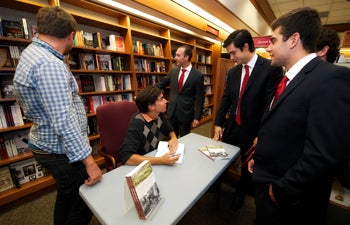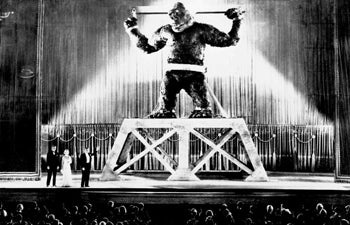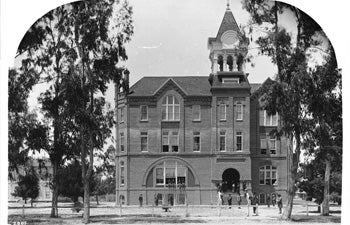Bet You Didn’t Know
Remember in The Graduate, when a desperate Benjamin Braddock (played by Dustin Hoffman) sped to “northern California” in his beat-up Alfa Romeo Spider to find Elaine?
USC stood in for the University of California, Berkeley, during the scene in which Ben watches Elaine as she skips down the steps of Doheny Library. At Alumni Park, a distressed Ben turns around and runs toward Bovard Auditorium.
There are many such gems in Charles Epting’s new book University Park Los Angeles: A Brief History (The History Press, 2013). With lifelong dreams of becoming a paleontologist, the junior majoring in geological sciences at USC Dornsife had no intention of writing a book about USC when he enrolled at the university three years ago, but the University Park campus inspired him.
“It’s hard not to get immersed in all the history when you are surrounded by these buildings and these legends. I start collecting fun facts, news articles, photos, anything I could find,” Epting said. “I wanted to explore every inch of campus.”
One of Epting’s favorite photos shows Greta Garbo flexing her arm with a USC track team coach in 1926.

USC Dornsife undergraduate Charles Epting signs his new book for some of his fraternity brothers at the USC Pertusati Bookstore. Photo by Dietmar Quistorf.
“Right as she was rising to stardom, Garbo was asked to do a PR shoot with the USC track team,” said Epting, who has minors in environmental studies and history. “She initially refused, but when the studio deducted $25 from her paycheck, she agreed to put on the track suit and take the pictures.”
One fan of the book is USC President C. L. Max Nikias, who was so impressed he met with Epting for a chat.
“He actually went online to get the e-book so he could read it before we met,” Epting said. “He’s buying copies for the entire Board of Trustees. He wanted to sit down with me and talk about what got me started writing the book at my young age. He was so supportive and so proud. It was fantastic.”
A week later, Epting was signing his book at the USC Pertusati Bookstore.
Feedback from students, parents and alumni has been “incredible,” Epting said. “Everyone who has read it has found something they’re interested in, which was my hope for the book.”

Key scenes in the 1933 blockbuster King Kong were shot inside the Shrine Auditorium, across from the USC University Park campus. The director filmed a miniature model of the ape and spliced the two images together to make it appear King Kong was actually on stage. Photo courtesy of Charles Epting.
Epting decided to write the book, he said, when his father, a historian and travel writer, prompted him to record his findings. His friends, too, encouraged him to write about all the fun facts he continually talked about as they walked around campus.
He wrote a book proposal, pitched a publisher and the rest, as they say, is history.
“I was really shocked, surprised and happy,” he said about the History Press purchase of his proposal. “It took about six months to get all the writing done, collect all the photos, do all the research. It was a really incredible process from start to finish.”
The publisher set up several book signings for Epting, including the event at the USC Bookstore, a building he documents in his 140-page, fact-packed historical inventory published in July.
“Thinking back to when I was writing this book, it is surreal that I did a book signing on campus, where I have spent the last year researching and writing,” Epting said.

Built in 1887, Old College housed the College of Liberal Arts and was demolished to make way for Founders (now Taper) Hall in 1948. Photo courtesy of Charles Epting.
Another of Epting’s favorite story is how USC got its “Trojans” nickname. During his research, the young author discovered that a Los Angeles Times reporter in 1912 wrote that one of the school’s teams “fought like Trojans.” But the writer was discussing the track and field team and not — contrary to popular belief — the football team, which had been temporarily replaced by a rugby team.
Some of USC Dornsife’s history graces the book. Completed Jan. 9, 1887, Old College housed the College of Liberal Arts, according to the book. It was built in a classical revival style and featured a 116-foot clock tower, science laboratories in the basement, a 500-seat chapel, offices and classrooms at a cost of $37,000. It was situated to the north of the original university building alongside University Ave. (now Trousdale Parkway). Old College survived for 60 years until it was demolished to make way for Founders (now Taper) Hall in 1948.
Epting’s personal history with USC dates back to his high school days when he volunteered at the Natural History Museum of Los Angeles County’s Dinosaur Institute. It was there that Luis Chiappe, head paleontologist and USC Dornsife adjunct professor of earth sciences, encouraged him to apply.
“I started looking at USC seriously,” Epting said. “Then I took a tour of campus, and I was just bitten by the bug.”

Senior Charles Epting pens a book chronicling the history of University Park beginning with the founding of USC in 1880.
At USC, Epting is a member of the Theta Chi fraternity and recently started working at USC Libraries’ Special Collections, where he is recataloging a 1940-1990 architectural collection.
Epting currently has another book in the works for History Press. The resident of Huntington Beach, Calif., is returning to his roots to write a book on the New Deal in Orange County. But his book deals have not altered his plan to pursue paleontology professionally, which will require a Ph.D., and USC Dornsife is definitely on his list.
“We have a really good geology graduate program. So I don’t see why I would need to move anywhere else,” he said. “I want to also keep writing and doing research. It is just so much fun to get wrapped up in this and combine science and humanities.”
USC Dornsife’s Pamela J. Johnson contributed to this report.